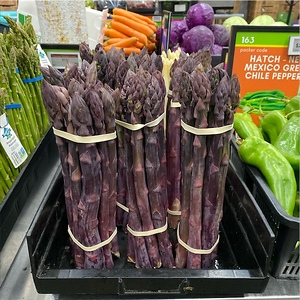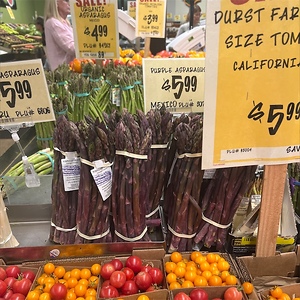


Purple Asparagus
Estimated Inventory, 11 lbs : 0
This item was last sold on : 12/18/24
Description/Taste
Purple asparagus is comprised of small to medium-sized upright, slender stalks that emerge from underground rhizomes in the soil. The stalks are also known as spears and have a straight nature, tapering at the crowned top of small, tightly packed leaves. Purple asparagus is typically harvested when it reaches 15 to 20 centimeters in length, and the stems can grow to be thick or thin, depending on cultivation. The stem's surface is smooth and firm, showcasing a dark purple, violet, and sometimes purple-blue hue, and the elongated but tiny, pointed leaves are variegated with shades of pale red, purple, and purple-green. Underneath the surface, the flesh is green, dense, crisp, and snappy with a tender, succulent crunch. Select Purple asparagus spears that are tightly closed and firm. The spears should also have a fresh, vegetal, and green aroma. Purple asparagus can be consumed raw or cooked and is known for having a higher sugar content than green asparagus varieties. The spears have a mild, sweet, and nutty taste with artichoke, almond, and barley nuances.
Seasons/Availability
Purple asparagus is available year-round, with a peak season in the spring through early summer.
Current Facts
Purple asparagus, botanically classified as Asparagus officinalis, is a category of perennial plants that produce pigmented, edible stems belonging to the Asparagaceae family. The upright, slender spears emerge in the spring and are valued as a culinary ingredient for fresh and cooked preparations. There are several varieties of Purple asparagus ranging from heirloom cultivars to modern types, and the three most widely available varieties include Erasmus, Pacific Blue, and Purple Passion. Purple asparagus cultivars are rare compared to their green counterparts, and the spears are typically sold as a specialty crop through farmer's markets. The pigmented varieties are only produced on a small-scale worldwide, and cultivars are also planted in home gardens as a novelty. Purple asparagus is sweeter and less fibrous than green and white asparagus, and the crisp stems are traditionally consumed raw to savor their flavor, unique coloring, and tender texture.
Nutritional Value
Purple asparagus is a source of vitamin C to strengthen the immune system while reducing inflammation, potassium to balance fluid levels within the body, and fiber to regulate the digestive tract. The variety also provides vitamin A to maintain healthy organ functioning, calcium to build strong bones and teeth, and other nutrients, including vitamin E, folate, and vitamin K. The purple pigments within the skin indicate the presence of anthocyanins, natural compounds with antioxidant properties to protect the cells against the damage caused by inflammation and oxidative stress.
Applications
Purple asparagus has a sweet, grassy, and subtly nutty taste suited for fresh and cooked preparations. Thinner spears are recommended for raw preparations and can be sliced and tossed into salads, placed as an edible garnish over main dishes, or displayed on vegetable platters. Try incorporating tender stems of green, white, and Purple asparagus in a salad to showcase their varying colors. Purple asparagus can also be shaved and mixed with spices and cheeses, layered into sandwiches, or integrated into grain bowls as added crunch. In addition to raw dishes, Purple asparagus can be utilized in any preparation calling for green or white asparagus. The purple coloring within the stems will fade with cooking, and the spears can be roasted, baked, grilled, steamed, blanched, or roasted. Purple asparagus can be cooked and added to pasta, stirred into risotto, or roasted and topped over pizza. The spears can also be used as filling for stuffed recipes, sauteed into omelets, folded into crepes, or steamed and served as a side dish to fish or meat dishes. Cook and toss the asparagus in high-quality olive oil, fresh herbs, and seasoning as a savory-sweet accompaniment. Purple asparagus can also be pickled as a tangy condiment. Purple asparagus pairs well with spring ingredients such as morel mushrooms, green garlic, wild ramps, fennel, and leeks, cheeses such as parmesan, pecorino, and alpine, hollandaise sauce, aromatics including garlic, shallots, and onions, eggs, seafood, and herbs such as basil, thyme, and parsley. Whole, unwashed Purple asparagus will keep up to one week wrapped in a damp paper towel and placed in a perforated bag in the refrigerator. The spears can also be placed upright in a glass of water and covered with a loose plastic bag in the fridge. For extended use, Purple asparagus can be blanched and frozen.
Ethnic/Cultural Info
In Albenga, Italy, the Violetto d'Albenga, translating to the violet asparagus of Albenga, is a rare variety of Purple asparagus still cultivated by hand that dates back to the 17th century. The variety is grown on the plains of Albenga, one of the few areas suitable for agriculture in Liguria, and the soil is comprised of a distinctive layer of sandy topsoil mixed with a microclimate ideal for asparagus production. One of the unique characteristics of Violetto d'Albenga is that its coloring was not developed from cultivation methods but from a genetic mutation. The asparagus variety has 40 instead of 20 chromosomes giving the stems their violet hue. This genetic mutation prevents the cultivar from being crossed with other varieties, making Violetto d'Albenga uncommon and valuable. Violetto d'Albenga is a labor-intensive crop that has almost disappeared from cultivation, but advocacy groups are seeking to protect the historical variety from extinction by promoting its importance in genetic diversity. Violetto d'Albenga is also a favored specialty ingredient added to meals during Easter in Liguria, especially in crespelle with ricotta, which is a crepe-like dish filled with fresh springtime ingredients.
Geography/History
Purple asparagus is believed to be native to Italy, and the modern-day cultivars are descendants of varieties that date back to ancient times. Asparagus, in general, can be traced to Mesopotamia, and the wild plant was introduced to Europe sometime during the Roman period, from 625 BCE to 476 CE. The Romans were one of the first European civilizations to cultivate asparagus, and the spears were used fresh and frozen for culinary and medicinal purposes. Over time, asparagus production spread throughout Italy, and extensive cultivation occurred during the Italian Renaissance. Purple asparagus varieties were mentioned in 15th-century cookbooks, and most violet-hued cultivars were grown in the commune of Albenga in the Liguria region of northwestern Italy. Growers selected the most desired traits within these varieties and bred the asparagus to have improved flavor and texture. There were once many different types of Purple asparagus produced in Liguria, but as agriculture evolved and other profitable crops were introduced, the labor-intensive nature of the asparagus caused it to fade from production. By the 17th century, only a few Purple asparagus varieties remained. In the modern day, breeders worldwide have studied Purple asparagus and created a few varieties for commercial and home garden cultivation. Purple asparagus is still challenging to find in markets and is rarer than green asparagus, but there are a few cultivars sold worldwide, especially in North America, Europe, and Australia. When in season, Purple asparagus is found in farmer's markets, distributors, and specialty stores. There are also varieties available for home garden cultivation.
Recipe Ideas
Recipes that include Purple Asparagus. One
| Boston Food and Whine |
|
Grilled Purple Asparagus with Dill Sauce |
| Weird Combinations |
|
Roasted Purple Asparagus with Semi-Dried Roma Tomates |
| 2 Stews |
|
Purple Asparagus with Lemon Chive Vinaigrette |
Podcast

















